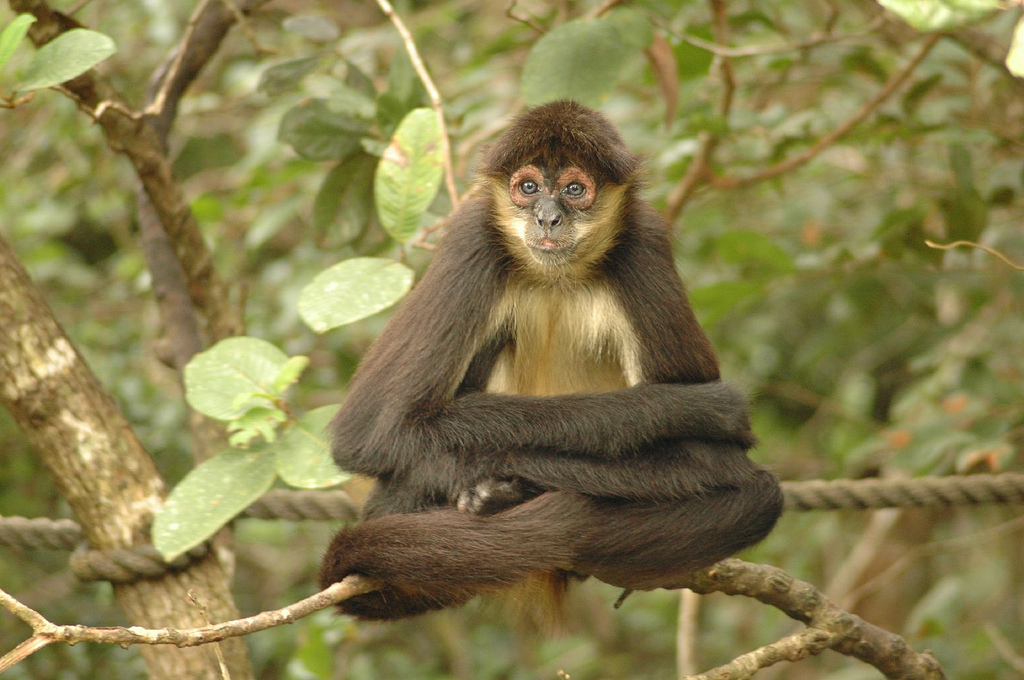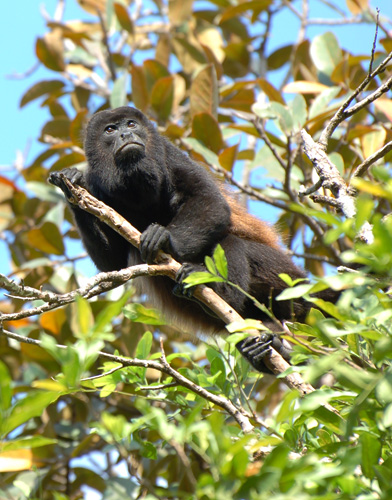|
Scent Rubbing
Scent rubbing is a behavior where a mammal rubs its body against an object in their environment, sometimes in ones covered with strongly odored substances. It is typically shown in carnivores, although many mammals exhibit this behavior. Lowering shoulders, collapsing the forelegs, pushing forward and rubbing the chin, temples, neck, or back is how this act is performed. A variety of different odors can elicit this behavior including feces, vomit, fresh or decaying meat, insecticide, urine, repellent, ashes, human food and so on. Scent rubbing can be produced by an animal smelling novel odors, which include manufactured smells such as perfume or motor oil and carnivore smells including feces and food smells. Scent rubbing is often performed with scent marking and self-anointing, and is typically used by animals to scent mark an object in their surroundings. This marking can be used as a means of communication between species. Many different species of felids, monkeys, bears, wolves ... [...More Info...] [...Related Items...] OR: [Wikipedia] [Google] [Baidu] |
Bobcat Rubbing Scent Post (6492408845)
The bobcat (''Lynx rufus''), also known as the red lynx, is a medium-sized cat native to North America. It ranges from southern Canada through most of the contiguous United States to Oaxaca in Mexico. It is listed as Least Concern on the IUCN Red List since 2002, due to its wide distribution and large population. Although it has been hunted extensively both for sport and fur, populations have proven stable, though declining in some areas. It has distinctive black bars on its forelegs and a black-tipped, stubby (or "bobbed") tail, from which it derives its name. It reaches a total length (including the tail) of up to . It is an adaptable predator inhabiting wooded areas, semidesert, urban edge, forest edge, and swampland environments. It remains in some of its original range, but populations are vulnerable to extirpation by coyotes and domestic animals. Though the bobcat prefers rabbits and hares, it hunts insects, chickens, geese and other birds, small rodents, and deer. Prey ... [...More Info...] [...Related Items...] OR: [Wikipedia] [Google] [Baidu] |
Grizzly Bear
The grizzly bear (''Ursus arctos horribilis''), also known as the North American brown bear or simply grizzly, is a population or subspecies of the brown bear inhabiting North America. In addition to the mainland grizzly (''Ursus arctos horribilis''), other morphological forms of brown bear in North America are sometimes identified as grizzly bears. These include three living populations—the Kodiak bear (''U. a. middendorffi''), the Kamchatka bear (''U. a. beringianus''), and the peninsular grizzly (''U. a. gyas'')—as well as the extinct California grizzly (''U. a. californicus''†), Mexican grizzly (formerly ''U. a. nelsoni''†), and Ungava-Labrador grizzly (formerly ''U. a. ungavaesis''†). On average, grizzly bears near the coast tend to be larger while inland grizzlies tend to be smaller. The Ussuri brown bear (''U. a. lasiotus''), inhabiting Russia, Northern China, Japan, and Korea, is sometimes referred to as the "black grizzly", although it is no more closely ... [...More Info...] [...Related Items...] OR: [Wikipedia] [Google] [Baidu] |
Olfactory Communication
Animal communication is the transfer of information from one or a group of animals (sender or senders) to one or more other animals (receiver or receivers) that affects the current or future behavior of the receivers. Information may be sent intentionally, as in a courtship display, or unintentionally, as in the transfer of scent from predator to prey. Information may be transferred to an "audience" of several receivers. Animal communication is a rapidly growing area of study in disciplines including animal behavior, sociology, neurology and animal cognition. Many aspects of animal behavior, such as symbolic name use, emotional expression, learning and sexual behavior, are being understood in new ways. When the information from the sender changes the behavior of a receiver, the information is referred to as a "signal". Signalling theory predicts that for a signal to be maintained in the population, both the sender and receiver should usually receive some benefit from the interact ... [...More Info...] [...Related Items...] OR: [Wikipedia] [Google] [Baidu] |
Sweat Gland
Sweat glands, also known as sudoriferous or sudoriparous glands, , are small tubular structures of the skin that produce sweat. Sweat glands are a type of exocrine gland, which are glands that produce and secrete substances onto an epithelial surface by way of a duct. There are two main types of sweat glands that differ in their structure, function, secretory product, mechanism of excretion, anatomic distribution, and distribution across species: * Eccrine sweat glands are distributed almost all over the human body, in varying densities, with the highest density in palms and soles, then on the head, but much less on the trunk and the extremities. Its water-based secretion represents a primary form of cooling in humans. * Apocrine sweat glands are mostly limited to the axillae (armpits) and perineal area in humans. They are not significant for cooling in humans, but are the sole effective sweat glands in hoofed animals, such as the camels, donkeys, horses, and cattle. Ceruminou ... [...More Info...] [...Related Items...] OR: [Wikipedia] [Google] [Baidu] |
Marmot
Marmots are large ground squirrels in the genus ''Marmota'', with 15 species living in Asia, Europe, and North America. These herbivores are active during the summer, when they can often be found in groups, but are not seen during the winter, when they hibernate underground. They are the heaviest members of the squirrel family. Description Marmots are large rodents with characteristically short but robust legs, enlarged claws which are well adapted to digging, stout bodies, and large heads and incisors to quickly process a variety of vegetation. While most species are various forms of earthen-hued brown, marmots vary in fur coloration based roughly on their surroundings. Species in more open habitat are more likely to have a paler color, while those sometimes found in well-forested regions tend to be darker. Marmots are the heaviest members of the squirrel family. Total length varies typically from about and body mass averages about in spring in the smaller species and in aut ... [...More Info...] [...Related Items...] OR: [Wikipedia] [Google] [Baidu] |
Woolly Monkey
The woolly monkeys are the genus ''Lagothrix'' of New World monkeys, usually placed in the family Atelidae. Both species in this genus originate from the rainforests of South America. They have prehensile tails and live in relatively large social groups. Taxonomy The following 2 species and 5 subspecies are currently considered to be within the genus: *Yellow-tailed woolly monkey, ''L. flavicauda'' (formerly placed in genus ''Oreonax'') * Common woolly monkey, ''L. lagothricha'' ** Gray woolly monkey, ''L. l. cana'' **Brown woolly monkey, ''L. l. lagothricha'' ** Colombian woolly monkey, ''L. l. lugens'' ** Silvery woolly monkey, ''L. l. poeppigii'' ** Peruvian woolly monkey, ''L. l. tschudii'' Description Woolly monkeys are closely related to spider monkeys. They have a thick brown coat with dark gray appendages. The stomach area is black and heads are light brown. The fur color is the same for both males and females. Variation in color exist among subspecies. A prehensile ... [...More Info...] [...Related Items...] OR: [Wikipedia] [Google] [Baidu] |
Rutaceae
The Rutaceae is a family, commonly known as the rueRUTACEAE in BoDD – Botanical Dermatology Database or family, of s, usually placed in the order . Species of the family generally have s that divide into four or five parts, usually w ... [...More Info...] [...Related Items...] OR: [Wikipedia] [Google] [Baidu] |
Old World Monkey
Old World monkey is the common English name for a family of primates known taxonomically as the Cercopithecidae (). Twenty-four genera and 138 species are recognized, making it the largest primate family. Old World monkey genera include baboons (genus '' Papio''), red colobus (genus '' Piliocolobus'') and macaques (genus '' Macaca''). Common names for other Old World monkeys include the talapoin, guenon, colobus, douc (douc langur, genus ''Pygathrix''), vervet, gelada, mangabey (a group of genera), langur, mandrill, surili (''Presbytis''), patas, and proboscis monkey. Phylogenetically, they are more closely related to apes than to New World monkeys. They diverged from a common ancestor of New World monkeys around 45 to 55 million years ago. The smallest Old World monkey is the talapoin, with a head and body 34–37 cm in length, and weighing between 0.7 and 1.3 kg. The largest is the male mandrill, around 70 cm in length, and weighing up to 50 kg. Old ... [...More Info...] [...Related Items...] OR: [Wikipedia] [Google] [Baidu] |
Spider Monkey
Spider monkeys are New World monkeys belonging to the genus ''Ateles'', part of the subfamily Atelinae, family Atelidae. Like other atelines, they are found in tropical forests of Central and South America, from southern Mexico to Brazil. The genus consistes of seven species, all of which are under threat; the brown spider monkey is critically endangered. They are also notable for their ability to be easily bred in captivity. Disproportionately long limbs and long prehensile tails make them one of the largest New World monkeys and give rise to their common name. Spider monkeys live in the upper layers of the rainforest, and forage in the high canopy, from . They primarily eat fruits, but will also occasionally consume leaves, flowers, and insects. Due to their large size, spider monkeys require large tracts of moist evergreen forests, and prefer undisturbed primary rainforest. They are social animals and live in bands of up to 35 individuals, but will split up to forage during ... [...More Info...] [...Related Items...] OR: [Wikipedia] [Google] [Baidu] |
Howler Monkey
Howler monkeys (genus ''Alouatta'', monotypic in subfamily Alouattinae) are the most widespread primate genus in the Neotropics and are among the largest of the platyrrhines along with the muriquis (''Brachyteles''), the spider monkeys (''Ateles'') and woolly monkeys (''Lagotrix''). These monkeys are native to South and Central American forests. They are famous for their loud howls, which can travel more than a mile through dense rain forest. Fifteen species are recognized. Previously classified in the family Cebidae, they are now placed in the family Atelidae. They are primarily folivores but also significant frugivores, acting as seed dispersal agents through their digestive system and their locomotion. Threats include human predation, habitat destruction, and capture for pets or zoo animals. Classification * ''A. palliata'' group ** Coiba Island howler, ''Alouatta coibensis'' *** ''Alouatta coibensis coibensis'' *** Azuero howler, ''Alouatta coibensis trabeata'' ** Mantled h ... [...More Info...] [...Related Items...] OR: [Wikipedia] [Google] [Baidu] |
Intraspecific Communication
Animal communication is the transfer of information from one or a group of animals (sender or senders) to one or more other animals (receiver or receivers) that affects the current or future behavior of the receivers. Information may be sent intentionally, as in a courtship display, or unintentionally, as in the transfer of scent from predator to prey. Information may be transferred to an "audience" of several receivers. Animal communication is a rapidly growing area of study in disciplines including animal behavior, sociology, neurology and animal cognition. Many aspects of animal behavior, such as symbolic name use, emotional expression, learning and sexual behavior, are being understood in new ways. When the information from the sender changes the behavior of a receiver, the information is referred to as a "signal". Signalling theory predicts that for a signal to be maintained in the population, both the sender and receiver should usually receive some benefit from the interact ... [...More Info...] [...Related Items...] OR: [Wikipedia] [Google] [Baidu] |
.jpg)


_great-egret-8243-web_(324180866).jpg)





